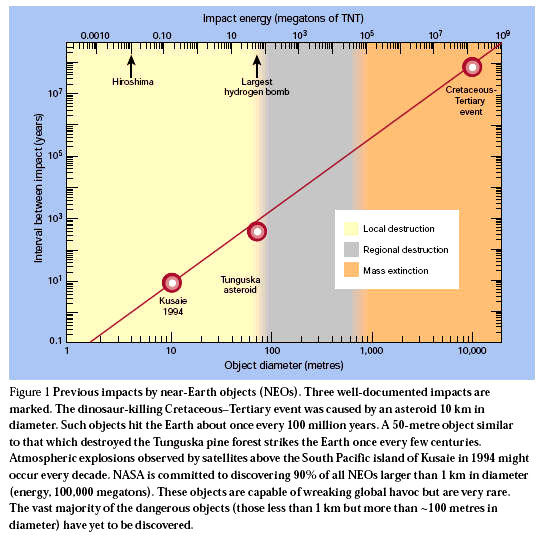|
13 JANUARY 2000
from Website
Astronomers like to forget that the roots of their subject lie in ancient superstitions about the influence of the cosmos on everyday affairs. In fact, astronomy and astrology were closely intertwined as recently as four centuries ago, when Tycho Brahe laid the foundations of modern astronomy while simultaneously maintaining a lucrative business in personal horoscopes.
Modern astronomers generally scoff at such superstitious beliefs, so it is somewhat ironic that science has in the past few decades uncovered compelling evidence for celestial interference in terrestrial matters. It is now clear that asteroids occasionally wander from the main belt beyond Mars because of chaotic instabilities caused by Jupiter. Some of these errant asteroids strike the Earth with terrible consequences. On page 165 of this issue, Rabinowitz et al.1 report that the number of threatening near-Earth objects (NEOs) larger than 1 km in diameter is only half the previous estimates. But we still have no effective means of detecting them all, and no form of self-defense.
The Earth bears the scars of previous encounters with NEOs. Hundreds of impact craters, some the size of small American states, have been discovered on the surface of our planet. Each was produced by a devastating explosion that must have been fatal to life in the surrounding areas on scales from local to global (Fig. 1).
The Cretaceous–Tertiary mass extinction of 65 million years ago seems to have been triggered by the impact of an asteroid 10 km in diameter2.
Ten thousand people killed by ‘falling stones’ in Shanxi Province, China, in 1490 were possibly the victims of a much smaller and thoroughly fragmented projectile. Still more recently, on 30 June 1908, 1,000 square kilometers of Siberian pine forest in Tunguska were blown flat by a 10-megaton atmospheric blast caused by a 70-metre asteroid.
The answer depends on the number of fatalities to be expected, but also on personal assessments of risk. The number of NEOs found by Rabinowitz et al. is within a factor of two of previous estimates based on less controlled samples, so published estimates of impact mortality are essentially unchanged. Considering events of all energies there is about 1 chance in 20,000 of being killed by an impact during the course of a human lifetime4, similar to the likelihood of being killed in an airplane accident.
The perception of risk from impacts is smaller than for being killed in a plane crash because planes crash at a steady rate with (relatively) few deaths per event, whereas lethal impacts are rare but kill a lot of people. At the very least, the potential consequences of impact are large enough to cause concern. In the past decade, thanks to several reported near-miss encounters with small objects, the impact threat has become a subject of intense interest to the general public (spawning the popular movies Deep Impact and Armageddon).
In 1994, the United States House Committee on Science and Technology went so far as to order the US space agency NASA to “catalogue within 10 years the orbital characteristics of all (Earth-orbit-crossing) comets and asteroids that are greater than 1 km in diameter”.
This particular cut-off diameter was picked in part because 1-km NEOs are thought to be the smallest objects capable of wreaking global havoc (for example, by disrupting the climate and shutting down photosynthesis). Smaller objects cause regional damage but would be unlikely to precipitate a major extinction like the Cretaceous–Tertiary event.
One option that has been discussed is the thermonuclear destruction of the incoming NEO (a bad idea because the shower of debris produced by the exploding NEO might be as damaging as the initial object, and would be radioactive). Given enough time, the NEO might be deflected from an Earth-intersecting path by a series of smaller explosions, or by attaching rockets or solar sails that use radiation pressure from the Sun.
The technology exists and tentative designs are beginning to appear 7-9. Such a telescope, which would have many applications in other branches of astronomy, is projected to cost about $100 million (about half the price of a Jumbo jet).
If not, it seems we will have to face the asteroidal impact hazard with our eyes wide shut.
References
|

